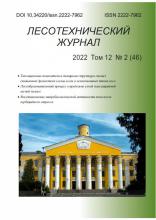Voronezh, Voronezh, Russian Federation
Voronezh, Voronezh, Russian Federation
Voronezh, Voronezh, Russian Federation
Given the high value of nuts of the genus Juglans, the increase of production must come not only by identifying and breeding the best varieties and forms, but also by shifting the limits of cultivation to the North, in "new" regions, where nut culture was not widespread. Objects of research were local forms of walnut, which grows in 19 administrative districts of the Voronezh region. Studied garden and field plantings, plantations, landscape group and separately standing trees. In determining the resistance of plants to adverse climatic factors used conventional techniques. The primary limiting factor for walnut is hardiness, hindering its mass deployment in culture to the North of the existing zone distribution. It hardiness has the worst indicator (2.26 points), compared to the other sustainability criteria. The maximum correlation of winter temperature are marked with the figures of March (r= 0.48) and April (r=0,45). It is established that neither the mean monthly climatic parameters separately does not show a high correlation with the winter hardiness of walnut, so you should consider set of factors. With the help of the dispersion analysis identified the most significant group of climatic factors that determine the successful development of plants, which were taken as a basis for conducting zoning. The greatest influence on the winter hardiness of walnut have a sum of active temperatures (above + 5°C) – ή =0.62 and as a consequence, the annual average temperature (°C) – ή =0.53. In order for the hardiness of the walnut was at an acceptable level, it is essential to acquire the sum of active temperatures more than 3000 °C. it is Revealed that with varying degrees of success walnuts can be grown in all districts of the Voronezh region. Selected 4 functional areas according to the degree of resistance to adverse factors.
Juglans regia, introduction, zoning, hardiness, climatic factors, assessment of prospects.
Учитывая высокую ценность орехов рода Juglans, увеличение их производства должно идти не только за счет выявления и разведения лучших сортов и форм, но и путем смещения предельной границы культивирования на север, в «новые» регионы, где орехоплодные культуры не имеют широкого распространения.
Орех грецкий (Juglans regia L.) по хозяйственной ценности, безусловно, является номером один среди орехоплодных пород. По совокупности полезных для человека свойств его можно отнести к наиболее ценным растениям планеты [5, 8]. Однако именно данный вид является наиболее теплолюбивым среди всех видов орехов рода Juglans и не всегда проявляет зимостойкие свойства вне естественного ареала [7].
1. Barannik L. P. Biologicheskie principy lesnoy recultivatsii [Bioecological principles for forest reclamation]. Novosibirsk, Nauka, 1988. 84 p.
2. Voronezhskiy region: archive pogody [Voronezh region: weather archive]. URL: http://www.meteotv.ru/weather/archive/
3. Lapin P. I., Sidneva S. V. Ocenka perspektivnosty introdukcii drevesnikh rastenii po dannym vizualnih nabludeniy [Assessment of the prospects of introduction of woody plants according to visual observations]. Opyt introdukcii drevesnikh rastenii [experience of the introduction of woody plants], 1973, pp. 7-63.
4. Meteorologicheskiy archive [Meteorological archive] URL: http://www.meteoblue.com/ru/ (2017)
5. Schepotyev F. L. and others. Orekhoplodnie drevesnie porody [Nut tree species] / - Moscow, Agropromizdat, 1985. 224 p.
6. Pogoda I Klimat Voronezha [Weather and Climate of Voronezh]. http://www.pogoda.ru.net/climate. (2017)
7. Slavskiy, V.A., Nikolaev E.A., Kalaev V.N. Introdukcya, selekcya and cultivirovanie orekhov roda Juglans v Centralnom Chernozemie [Introduction, selection and cultivation of nuts of the genus Juglans in the Central Chernozem region] Voronezh, Wind Rose, 2013. 262 p. EDN: https://elibrary.ru/RUFSZJ
8. Slavskiy, V.A., Nikolaev E. A. Sravnitelnaya kharakteristika orekhov roda Juglans v Centralnom Chernozemie i perspektivy ih vnedrenia [Comparative characteristics of nuts of the genus Juglans in the Central Chernozem region and prospects of their introduction in culture] Arkhangelsk, ASTU: Lesnoy journal [Forest journal]. 2009. no. 6, P.56-62.
9. Sukhorukih, Y.I. Orekh gretskiy: biologya, selekcya, razvedenie [Walnut: biology, selection, breeding] Maykop, MGCI, 1997. 235 p. EDN: https://elibrary.ru/TLSSLR
10. Tretyakov, N. N. Practicum po physiologii rastenii [Practicum on plant physiology]: teaching aid. - Moscow, Colossus. 2003. 228 p. EDN: https://elibrary.ru/WFCDFH
11. Cedro A., Lamentowicz M. Contrasting responses to environmental changes by pine growing on peat and mineral soil: An example from a Polish Baltic bog. Dendrochronologia, v. 29, 2011. pp. 211-217.
12. Matveev S.M. Chendev Yu.G., Lupo A.R., Hubbart J.A., Timashchuk D.A. Climatic Changes in the East-European Forest-Steppe and Effects on Scots Pine Productivity. Pure and Applied Geophysics, 2016. DOIhttps://doi.org/10.1007/s00024-016-1420-y. EDN: https://elibrary.ru/XGRBXT
13. Matskovsky V., Dolgova E., Lomakin N., Matveev S. Dendroclimatology and historical climatology of Voronezh region, European Russia, since 1790s. Int. J. Climatol, 2016. DOI:https://doi.org/10.1002/joc.4896. EDN: https://elibrary.ru/WZNNNX
14. Poulter B., Pederson N., Liu H., Zhu Z., D’Arrigo R., Ciais R., Davi N., Frank D., Leland C., Myneni R., Piao S., Wang T. Recent trends in Inner Asian forest dynamics to temperature and precipitation indicate high sensitivity to climate change. Agricultural and Forest Meteorology, v. 178-179. 2013, pp. 31-45. DOI: https://doi.org/10.1016/j.agrformet.2012.12.006; EDN: https://elibrary.ru/RHXRQJ












